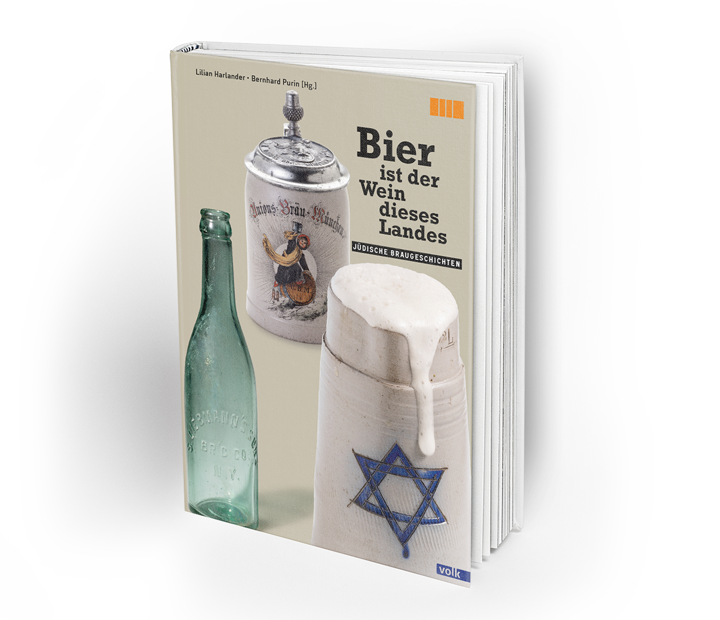Beer is the Wine of this Land
Jewish Brewery Tales


Hops, water, yeast, and malt: these are the four ingredients with which beer is traditionally brewed in Bavaria. The 500th anniversary of the “Bavarian Beer Purity Law,” which has now been added to the Intangible Cultural Heritage list, will be celebrated in 2016. To mark this jubilee the Jewish Museum Munich is staging the first exhibition of its kind to explore the story of beer, past and present, in Jewish tradition and culture.
In Ancient Egypt beer became a staple drink and it was there that the Isrealites became acquainted with it. For them the question arose as to whether beer had to…
Hops, water, yeast, and malt: these are the four ingredients with which beer is traditionally brewed in Bavaria. The 500th anniversary of the “Bavarian Beer Purity Law,” which has now been added to the Intangible Cultural Heritage list, will be celebrated in 2016. To mark this jubilee the Jewish Museum Munich is staging the first exhibition of its kind to explore the story of beer, past and present, in Jewish tradition and culture.
In Ancient Egypt beer became a staple drink and it was there that the Isrealites became acquainted with it. For them the question arose as to whether beer had to be kosher and if it could be used for ritual purposes like wine. When beer is the principal beverage rather than wine, the Talmud stipulates that “beer is the wine of this Land” and may be used. Another section of the exhibition looks at what the “Brauerstern” – the brewers’ star – and its equivalent in the Upper Palatinate region, the “Zoigl,” have to do with the Star of David. The history of the hop trade, which in southern Germany was significantly influenced by Jewish merchants over a long period, is also clearly traced. Evidence is provided of how the decoration of beer steins, namely their painting as well as the manufacture and fitting of pewter lids, was likewise an industry primarily developed and operated by Jews in Munich.
Jewish brewers from Munich and the surrounding area form one of the focal points of the exhibition. The baronial von Hirsch family built one of the first modern, industrially operated breweries in Bavaria “on a green field” site in Planegg in 1836. During the almost 100 years of its existence it became a model for other modern brewery plants. In 1895, Josef Schülein – who came from a small rural Jewish community in Middle Franconia – established Unionsbrauerei Schülein & Cie in Munich, which swiftly expanded to become Munich’s second largest brewery. He and his son Hermann were responsible for the merger with Löwenbräu AG in 1921. While Josef Schülein withdrew to Schlossbrauerei Kaltenberg, Löwenbräu went on to become the most important export-oriented brewery in Munich under its managing director Hermann Schülein. After the National Socialists forced him to resign, Schülein emigrated to the USA where he turned the Liebmann Brewery in New York, with its “Rheingold” brand of beer, into one of the USA’s major breweries. His innovative advertising methods, such as the annual election of “Miss Rheingold” and the involvement of stars like Louis Armstrong, Nat King Cole, Marlene Dietrich, Ella Fitzgerald, and John Wayne in advertising campaigns, are still regarded as exemplary in branding and brand management in the USA today.
The last section of the exhibition is devoted to the beer culture in present-day Israel which, on the one hand, is markedly influenced by the German brewing tradition and German types of beer and, on the other hand, has a surprisingly young and diverse craft beer scene. For the first time craft breweries from Germany and Israel – CREW Republic from Munich and Herzl Brewery from Jerusalem – will jointly be creating a “collaboration brew” to mark the exhibition which will be available at the café in the Jewish Museum Munich.
April 13, 2016 - January 8, 2017
Bernhard Purin
Lilian Harlander
Architekt Martin Kohlbauer, Vienna
PUBLIKATION
Anlässlich des 500. Jubiläums des Reinheitsgebots beleuchtete das Jüdische Museum München in einer Ausstellung erstmals die Geschichte und Gegenwart des Bieres in der jüdischen Tradition und Kultur.
In zahlreichen Bereichen der Ausstellung geht es u.a. um den Brauerstern und inwiefern seine oberpfälzische Ausprägung, der »Zoigl«, mit dem Davidstern zusammenhängt. Es wird anschaulich die Geschichte des Hopfenhandels in Süddeutschland erzählt. Außerdem wird nachgewiesen, dass die Bemalung von Krügen sowie die Herstellung und Montage der Zinndeckel, ein maßgeblich von jüdischen Münchnern entwickeltes und betriebenes Gewerbe war. Und auch Jüdische Brauherren in München und Umgebung bilden einen Schwerpunkt der Ausstellung.
